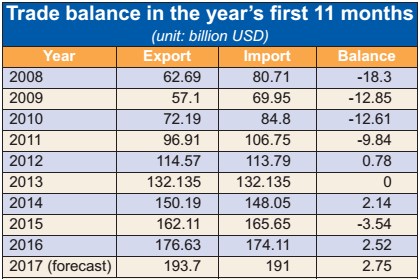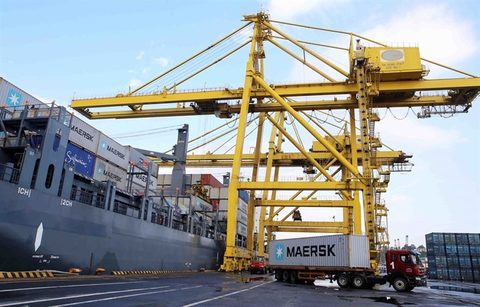Strong second half of year results in big trade surplus
Strong second half of year results in big trade surplus
Vietnam has enjoyed a record 11-month trade surplus, reflecting a strong second half of the year in firms’ export-import performance.

The General Statistics Office reported that, overall, the economy witnessed a record trade surplus of $2.75 billion in the year’s first 11 months.
This number came on the back of a total export turnover of $193.8 billion, up 21.1 per cent year-on-year. Local enterprises earned $53.1 billion, up 16.8 per cent year-on-year, and foreign enterprises raked in $140.7 billion (including crude oil exports), up 22.8 per cent year-on-year.
Meanwhile, the import turnover reached $191 billion, up 21 per cent year-on-year – with locally-owned firms fetching $76.5 billion (up 18 per cent year-on-year) and foreign firms raking in $114.5 billion (up 23.2 per cent year-on-year).
Foreign enterprises held a trade surplus of $26.2 billion, while local enterprises suffered from a trade deficit of $23.4 billion.
Over the course of 2017, there has been an inversion in the trade situation. In the year’s first half, the economy suffered from a trade deficit of $2.78 billion, with each of the first six months registering a trade deficit.
But the situation got better in July, as a trade surplus of $266 million was recorded in the month. The seven-month figure still added up to a trade deficit of $2.53 billion.
September brought with it a trade surplus of $1.1 billion, making for a trade surplus of $328 million over the year’s first nine months. October’s trade surplus came to $2.18 billion, resulting in a trade surplus of $2.56 billion in the year’s first 10 months.
It is expected that the figure will climb higher over the whole of 2017, given the better export-import situation, with export turnover likely to reach about $210 billion.
In the recent past, foreign firms have unwaveringly enjoyed a trade surplus, while that same consistency held for local firms in ringing up trade deficits year after year.
The fact that local enterprises have predictably seen a trade deficit has affected the economy’s trade balance.
Vietnam saw a trade surplus of $2.5 billion last year, and a surplus could also be seen in 2012 and 2014 – when the surplus reached more than $2.1 billion. However, 2015 showed a worrying deviation in a trend of growing trade surpluses, with a deficit of $3.5 billion.
According to experts, the instability in Vietnam’s trade balance showed that the country’s export-import structure remains unstable, that local production remains largely dependent on imported materials, and that the connection between foreign firms and local ones remains lax.
The General Statistics Office reported that 2017’s 11-month export turnover showed key items soaring year-on-year, including mobile phones and their spare parts ($41.3 billion – up 30.6 per cent); electronics, computers, and their spare parts ($23.6 billion – up 38.1 per cent); garments and textiles ($23.6 billion – up 9.5 per cent); footwear ($13 billion – up 11.6 per cent); and machines and their spare parts ($11.5 billion – up 27 per cent).
Meanwhile, the 11-month turnover of many imported items used for production climbed year-on-year, such as electronics, computers, and their spare parts ($34 billion – up 34 per cent); machinery and equipment ($30.7 billion – up 20.7 per cent); mobile phones and their spare parts ($14.4 billion – up 50.2 per cent); cloth ($10.3 billion – up 8 per cent); steel ($8.3 billion – up 14.3 per cent); plastic ($6.7 billion – up 17.8 per cent); and garment and footwear materials ($5 billion – up 8.1 per cent).




















